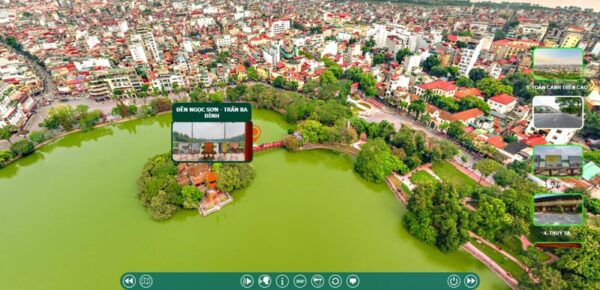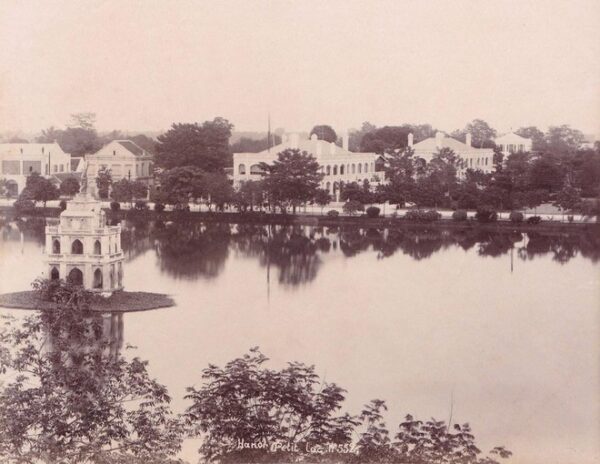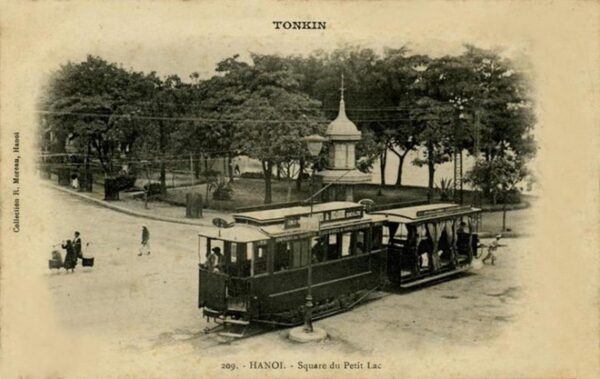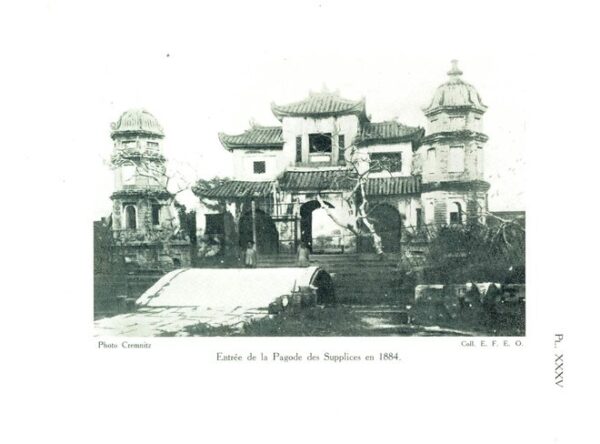
With over 100 documents, materials, pictures, drawings on display, the online exhibition helps the public have good memories of the past Sword lake.
Ho Guom (the Sword lake) – a remnant section of the past Nhi Ha river, a famous attraction of the Capital, is surrounded by the streets of Hang Khay-Le Thai To-Dinh Tien Hoang. With its favourable location, Ho Guom was chosen by the French as the centre for Making it into a nowaday Ha Noi right after they had arrived. In the eyes of the French architects, Ho Guom was seen as a crossroad-a meeting point of the East-West architectural styles and cultures, which was a harmonious combination between native quarters in the north and expatriate quarters in the south. Together with the old habits, the traditional life styles of Hanoians, the new facade of a western urbanity had brought many modern things to the native people’s life. Such the resonance had created an authenticity to present Ho Guom and the old Ha Noi quarters. The exhibition comprises of 3 themes: Changes of Ho Guom facade; Conserving Ho Guom’s historical, cultural space; Ho Guom-Centre of services and cultural leisures.

Sword lake (documentary photo).
In Section I, the exhibition will take the audience to witness changes of Ho Guom throughout the length of the past history. Before the French started to buil the fortified structures on the land concession with in-between road (Pham Ngu Lao street nowaday) in1873, Ho Guom was somehow like a countryside lake.

Past Ho Guom was somehow like a countryside lake.
Since 1884 till now, Ho Guom has become the central point of Ha Noi city palnning. The French administration had opened a street which links the land conccession zone with the Examination Compound and old Imperial Citadel. During the course of construction, the Governor in charge of the north and central regions in Viet Nam requested the surroundings of the lake be kept with its length of 20 metres at least, no structure be built and all thatched roof houses on Paul Bert street be demolised. In the cause of the city’s renovation, Ho Guom has created the differrences compared with other western style urbanities, and it bears deeply the oriental-Asian Architectural genre. Ho Guom has become the “East-West crossroad”, this is a reasonal combination between the native quarters in the north and the western quarters in the south as André Masson said: “Present Ho Guom is a necklace of Ha Noi city, a burstling dash between the native quarters and the French quarters”.

Hoan Kiem lake’ square (documentary photo).
Section II of the exhibition shows the audience that Ho Guom has been conserved and kept throughout hundred years with various policies underway.
After assuming power in 1884, Bonnal rushed to design plans for the city reconstruction, in which there was a rehabilitation of Ho Guom into a leisure area, demarcating a ring road around the lake. To settle this matter, all of thatched roof houses, temples, pagodas and worship places like Ba Kieu, Bao An, Le King had been removed except for the structures on the island of Ngoc Son and Quy Son.
This act had prompted the waves of outrage not only among Ha Noi residents, but also the French officials. In that context, the Indochinese Governor had signed the Decrees dated 09 March, 1900 and 15 April, 1905 on the conservation of Ha Noi city’s historical works (including Ngoc Son templetrong đó có đền Ngọc Sơn and Pen tower). In 1925, according to the Decree dated 11 July by the Governor of the Indochinese region, any classified historical and religious works, needed repairing, had to be handled through the request of the National Old Relics Conservation Department. After 1937, Ha Noi city Governor had issued the decision on the change of use purposes for a number of historical and religious works in Ha Noi. Under that Decree, some works would have to be completely dismantled, and some trimmed in part.
Nowadays, in Ho Guom area and its vicinity there concentrates lots of traditional historical, cultural, architectural, artistic structures mixed with a space of green trees and water surface. Therein, one can realize a depth of the unique culture and architecture as: Ngoc Son temple, The Huc bridge, Pen tower, inkstone, Turtle tower, Hoa Phong tower, ect… Through numerous ups and downs of the history, the lost and remained, the old and new intertwined and mixed one another have shaped the cultural space of Ho Guom.
Bao An pagoda 1884.
The Section III of the exhibition one again reasserts that Ho Guom is the centre of cultures, services and leisures of the Capital and the entire country. With a view to turning Ho Guom and its vicinity into the cultural, political, religious, trade, service and leisure centre within Ha Noi, the French administration had built villas, administrative compounds, public offices in the east of Ho Guom. Many plants, enterprises, shops, restaurants, trading agencies grew around Ho Guom, and the expatriate streets had also appeared. The European-style entertainment and recreational areas had been set up like Opera house, clubs, swimming pools. The spiritual and physical lifestyle had been gradually mixed with the Westernizational element. The tastes ranging cuisines (bread, ice water, coffee, beer) to the liking of arts had changed…
It can be said that it was until the early half of 20th century the spiritual and cultural lifestyle of Hanoians saw a radical change when a tier of civil servants and cityfolks of native Ha Noi came up. They changed their styles of wearing, house decoration and followed the westernized way of life. With more than 100 documents, archives, pictures and drawings on display, it is expected that will bring to the community with good memories of the past Ho Guom.
Thu Huong
